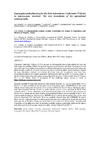Please use this identifier to cite or link to this item:
https://accedacris.ulpgc.es/jspui/handle/10553/107222
| Title: | Lagrangian path planning for the first Autonomous Underwater Vehicles in transoceanic missions: The new boundaries of the operational oceanography | Authors: | González Ramos, Antonio Juan García Garrido, V. J. Glenn, S. Kohut, J. Schofield, O. Aragon, D. K. Strandskov, N. Mancho, A. M. Wiggins, S. Coca, J. |
UNESCO Clasification: | 331913 Vehículos submarinos 220404 Mecánica de fluidos |
Keywords: | South Atlantic Crossing Autonomous Underwater Vehicles (AUVs) Path planning Lagrangian Descriptors Hyperbolic Trajectories, et al |
Issue Date: | 2016 | Conference: | Third International Workshop Nonlinear Processes in Oceanic and Atmospheric Flows | Abstract: | Unmanned Underwater Vehicles (UUVs) are used in Oceanography due to their relative low cost and wide range of capabilities. Gliders change their buoyancy in order to dive and climb, describing a vertical saw tooth route. These diplacements produce an effective although low horizontal speed which makes the glider strongly sensitive to the ocean dynamics. In order to control the glider path its heading is adapted by using information obtained from verified 4D current data sets. In particular from these data, Lagrangian descriptors have supplied potentially useful paths for piloting the RU-29 Challenger glider in the first South Atlantic Circunnavigation crossing flight (760 days-sea, 17400 km) held from 16th January 2013 to 31st March 2016). A description of the Challenger glider mission is found at http://challenger.marine.rutgers.edu/ . Invariant manifolds of hyperbolic trajectories were obtained from the real time 4D current fields (1º/12) forecast (+5 days) provided by the european marine forecasting system COPERNICUS in the South Atlantic domain during the last quarter of the mission (1500km far from S Africa). Manifolds outputs were then compared with the ground true paths and the ground currents provided by RU29 when surfaced (every 14 hours). Preliminary results reported by the glider at its arrival at Cape Town (end of March, 2016), showed that the strong Agulhas current/mixing dynamics, was not captured by any of the 5 current models (Copernicus, Hycom, Oscar, NRTOFS, Glory) used for the comparison. Prior to this stage however (December 2015-mid March 2016) the manifolds obtained from the COPERNICUS current fields showed a high percentage of confident good routes that were confirmed by the ground true flying paths reported by the glider nearing the South African ZEE border (10th March 2016). The preliminary combination of the glider data with the invariant manifolds suggests a potentially useful tool for gliders path planning in future long range transoceanic glider missions (Indian Ocean 2017-). | URI: | https://accedacris.ulpgc.es/handle/10553/107222 | Source: | Third International Workshop Nonlinear Processes in Oceanic and Atmospheric Flows 6-8 July 2016, ICMAT, Campus Cantoblanco UAM, Madrid, Spain | URL: | http://nloa2016.ifisc.uib-csic.es/detail/contrib/12/ |
| Appears in Collections: | Actas de congresos |
Page view(s)
151
checked on Mar 2, 2024
Download(s)
39
checked on Mar 2, 2024
Google ScholarTM
Check
Share
Export metadata
Items in accedaCRIS are protected by copyright, with all rights reserved, unless otherwise indicated.

